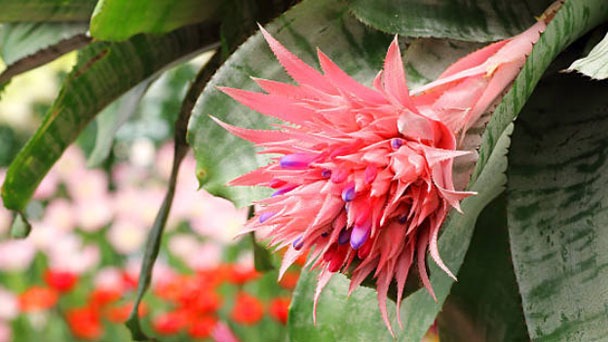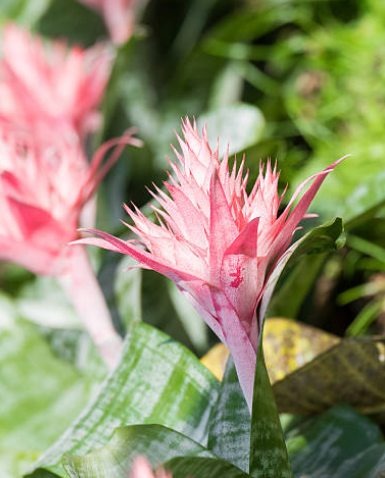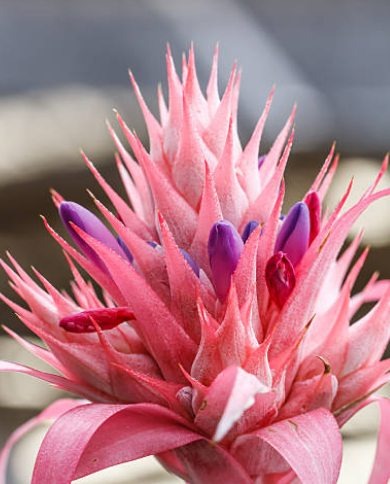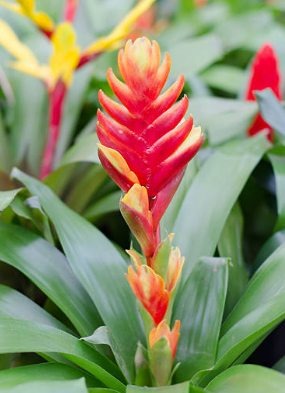How to Grow & Care for Blushing Bromeliad
Written by Ivy
Dec 30 2022

Due to the way the leaves in the center of Neoregelia carolinae change from green to bright red as the plant starts to bloom, it is known as the Blushing Bromeliad.
It is renowned for its stunning, three-toned leaves, which are green on top and red toward the center, giving the impression that it is blushing. It stands out among houseplants due to its vibrant leaves and delicate flowers, and gardeners of all abilities love it for its simplicity in maintenance.
Blushing Bromeliad Description
Around 100 different species of neoregelias belong to the bromeliad family. They are small, up to 2 feet wide and 2 inches tall. They typically form a "cup" in the middle which gathers water and debris for nutrition The margins of their leaves frequently have spines in the form of spots, bands, or marbles. When about to bloom, the central leaves will frequently turn red.
They require a sunny location inside the home for the best leaf color and typically tolerate temperatures between 50 and 90 degrees. To create a dry environment, plant in a medium without soil. Allow the potting medium to completely dry in between waterings and keep the central vase filled with fresh water—rainwater is ideal.
Small, tubular blooms of the flowers appear in the center vase and begin to open one at a time. More often than not, this plant is grown for its leaves rather than its flowers. Once the plant has finished blooming, it will form "pups" at the base of the plant which when big enough can be removed and repotted. The mother plant will wither and pass away.

Blushing Bromeliad Main Characteristics
| Common Name | Blushing Bromeliad |
| Botanical Name | Neoregelia carolinae ‘Tricolor' |
| Family | Bromeliaceae |
| Genus | Neoregelia |
| Type | Epiphyte |
| Native Range | Garden Origin |
| USDA Hardiness Zones | 10 to 11 |
| Mature Size | Height: 0.75-1.50 feet; Spread: 0.75-1.50 feet |
| Bloom Time | Summer |
| Foliage | Evergreen |
| Propagation methods | by seed, by offsets |
| Sun | Part shade to full shade |
| Soil | Moist, Well–drained |
| Toxicity | Non-Toxic |
How to Care for Blushing Bromeliad
Light and Location
It is best to keep this plant in a location with direct sunlight for a few hours each day because it prefers bright to medium light. However, keep it out of the hot afternoon sun as it can burn there. If necessary, these plants can tolerate deep shade, but the growth won't be as lush.
Watering
Blushing Bromeliad Watering: The central "vase" must always be filled with water in Blushing Bromeliads, just like other rosette Bromeliads. To avoid the development of bacteria that could make the water smelly, empty and refill the "vase" frequently.
Because Blushing Bromeliads are sensitive to chlorine and other chemicals that may be dissolved in water, only use water that is chlorine-free for them.
To keep the roots moist, water the Blushing Bromeliad's soil only when it dries. For your Blushing Bromeliads, stay away from soggy soil because it can cause root rot and ultimately cause the plant's death.
Soil
Blushing Bromeliad Soil: The ideal soil for Blushing Bromeliads should be rich in organic matter, loose, and free-draining bark soil to keep it from becoming soggy while providing the necessary nutrients. Blushing Bromeliads do best in the majority of orchid potting mixtures.
Temperature
The best temperature for growing your Blushing Bromeliad indoors is an average warmth with a minimum of 150C. However, to bring the Blushing Bromeliad to flower requires temperatures above 260C.
Humidity
Humidity is necessary for blushing bromeliads. The plant's leaf tips turn brown if the humidity is too low.
Use a cool mist humidifier or place the pot on a tray of wet pebbles to increase humidity for your Blushing Bromeliad. See how to increase humidity for indoor plants using these methods.
To avoid pest and disease infestation, make sure your Blushing Bromeliads have adequate air circulation.
Fertilizer
Blushing Bromeliad Fertilizer: Throughout the growing season, give Blushing Bromeliads a foliar feed (liquid fertilizer) every two weeks.
During the cold season, avoid feeding your Blushing Bromeliad because growth is minimal and doing so could cause fertilizer burn.
Repotting
Because the Blushing Bromeliad's roots are so small, repotting is not necessary to prevent the pot from becoming overflowing. To avoid tipping over because it can become top-heavy, plant your Blushing Bromeliad in a shallow, heavy pot.
Additionally, give your Blushing Bromeliad support so it can remain upright. Learn more about how to train houseplants.
Pruning
To keep your plant tidy and provide enough space for the new plants to grow, pruning Blushing Bromeliad involves removing any dead leaves.
Using a clean, sharp knife or a pair of scissors, trim the base of the dead foliage to remove it from your Blushing Bromeliad. Cut the spent bloom from your Blushing Bromeliad at the base using a clean, sharp knife or a pair of scissors.

Propagating Blushing Bromeliad
The main method of propagating blushing bromeliads is by taking offsets from the side of the plant. Search for small sections of the plant that are growing apart from the main stem because bromeliads frequently send out offsets around the plant base. After blooming, the mother plant usually starts to wilt and die, allowing the pups to take its place. You can either remove an offset that is big enough to start a new plant early or let nature take its course.
Waiting for the offset to reach a sufficient size is difficult. It must either be a third the size of the mother plant or already be forming thin, spindly roots. Simply twist and pull to remove it. The offset should then be planted in a brand-new pot and covered with a plastic bag to increase humidity. In a few weeks, the plant ought to begin to establish roots in the soil.
Using seeds for propagation is another option. However, this procedure might take a while to finish, and it's typically much simpler and more effective to just use offsets.
When the Blushing Bromeliad offset (pup) is several months old or 1/3 to 1/2 the height of the mother plant, cut it from the mother by cutting with a sharp, clean knife or scissors.
Plant the Blushing Bromeliad offset shallowly in loose, free-draining bark soil, making sure the offset has some roots attached.
Because it can become top-heavy, a shallow, heavy pot will help keep your Blushing Bromeliad from falling over. Due to its small root system, the Blushing Bromeliad should be firmly supported to avoid toppling over.
Until the new Blushing Bromeliad plant is firmly established, keep the setup in a warm, shaded area. Then, start providing routine care.
Blushing Bromeliad Common Pests
Because they prefer similar conditions to those that bromeliads are used to, aphids, thrips, and scales can cause problems for your bromeliad. As a result, you should use an ordinary insecticide to get rid of any pests you spot on your plant right away. Consult a pest control expert if that doesn't work.
Blushing Bromeliads (Neoregelia Bromeliads) Problems
The main causes of Blushing Bromeliads (Neoregelia Bromeliads) problems indoors are societal shortcomings in lighting, humidity, and watering. For the remedies and solutions, keep reading.
Blushing Bromeliad Brown Leaf Tips
Low humidity causes the brown leaf tips on bromeliads to blush. For the plant to flourish, the environment must be humid.
Use a cool mist humidifier or place the pot on a tray of wet pebbles to increase humidity for your Blushing Bromeliad.
Blushing Bromeliad Pale Brown Leaf Patches
The direct sunlight exposure of a bromeliad causes pale brown leaf patches to blush. The bromeliad needs bright light, but it can't stand direct sunlight.
Direct sunlight exposure is not good for the blushing bromeliad. Put a barrier between it and the sun, or relocate it to a more shady area.
Blushing Bromeliad Dark, Soft, Drooping, Long Leaves
Lack of light (too little light) is the cause of Blushing Bromeliads' dark, soft, drooping, long leaves. Bright, indirect light is ideal for Blushing Bromeliad growth.
Away from direct sunlight, move the Blushing Bromeliad to a spot with more light. Additionally, a grow light can help it grow.
Blushing Bromeliad Dying
There are two potential causes for the death of a blushing bromeliad. One explanation is that Root-rot Disease brought on by soggy soil is the cause of death if the Blushing Bromeliad hasn't flowered.
The second reason is that if the Blushing Bromeliad has flowered, it is only natural for the rosette that produced the flower stalk to rot and die in order to make room for the new plants.
To make room for the new plants, cut the dead foliage from your Blushing Bromeliad at the base with a clean knife or a pair of scissors.
Is Blushing Bromeliad (Neoregelia Spp) Toxic?
Neoregelia spp., or blushing bromeliads, are non-toxic to both people and animals. Indoor growing of the plants is secure.
Although your Blushing Bromeliad's leaves have short spines, handling them with bare hands could result in physical harm. To avoid harm, put on gloves whenever you handle your Blushing Bromeliad.

Conclusion
A happy and easy-to-care-for houseplant needs bright light, warm temperatures, and a mildly humid atmosphere.
Neoregelia carolinae requires a lit display that is shielded from the sun. They cannot withstand temperatures below 10 ºC in the winter and need to rest at 15 ºC. They prefer an average temperature of 25°C in the spring and summer.
Peat, heather soil, garden soil, and coarse sand can all be combined in the soil in the same proportions. Another option is to combine it with two parts peat and one part coarse sand. For a fresh substrate, plant in the spring.
While allowing the substrate to dry, water moderately with water free of lime; the center of the rosette must always have water. The air must be very humid; in the spring, summer, and once a week in the winter, spray lime-free water on the leaves to ensure this.
Use low calcium mineral fertilizer when fertilizing, twice a week in the spring and summer.
Latest Updated
- Benefits of Bugleweed - 7 Science-backed Health Benefits
- Bugleweed Dangers & Side Effects - Is It Poisonous?
- How to Plant Evergreen Trees - What You Should Know
- When to Plant Evergreens - Grow Guide for Evergreen Trees
- 12 Wonderful Evergreen Shrubs for Your Garden
- 12 Popular Evergreen Plants with Pictures for Beginners
- When And How To Prune A Lilac Bush Like a Pro
- How to Grow & Care for Lilac Vine (Hardenbergia Violacea)
- Japanese Lilac Tree (Syringa Reticulata) Care & Propagation Guide
- Shumard Oak Pros and Cons - What to Know
Popular Articles
- Winter maintenance of Antirrhinum Majus
- How to Grow Terminalia Mantaly Tree
- How to Grow and Care for Crossostephium Chinense
- How to grow Antirrhinum Majus in spring
- Peristeria Elata (Dove Orchid) Profile: Info & Care Guide
- Underwatered Snake Plant (Sansevieria Trifasciata) - Signs And How To Fix
- How to Care for Brazilian Jasmine Plant (Mandevilla Sanderi)
- How to Grow & Care for Graptopetalum Purple Delight in Summer
- Rosa Chinensis (China Rose): Plant Growing & Care Tips
- How to Care for Baby Sun Rose (Aptenia Cordifolia)